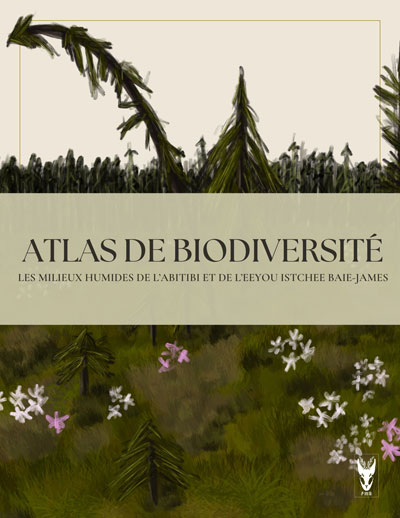
Emma Despland
Membre régulier
Interactions plante-insecte
Université Concordia
Faculté des arts et sciences
Département de biologie
7141, rue Sherbrooke Ouest
Montréal (Québec) Canada, H4B 1R6
(514) 848-2424 Poste 3426
FORMATION
- Postdoctorat en zoologie, 2001 (University of Oxford, UK)- Canada-UK Millennium Fellow
- Ph.D. en zoologie, 1999 (University of Oxford, UK)
- M.Sc. en biologie, 1995 (Université Laval)
- B.Sc. en biologie environnementale, 1992 (McGill University)
THÈMES DE RECHERCHE
La livrée des forêts (Malacosoma disstria) est un ravageur épidémique Canadien qui cause des dommages significatifs à l'environnement naturel tout comme aux industries forestières. La livrée est une espèce sociale; elle vit en colonies de plusieurs centaines d'individus qui utilisent des pistes de phéromone pour se déplacer entre les sites où ils se nourrissent. L'activité d'une colonie est synchrone et les individus alternent ensemble entre des périodes de repos et de quête alimentaire.
Mon programme de recherche vise à comprendre comment les chenilles profitent à chercher leur nourriture en groupe plutôt que seules. En particulier, j'étudie comment les chenilles communiquent avec leurs voisines pour se synchroniser entre elles et comment chaque individu concilie ses propres besoins nutritionnels avec l'horaire des déplacements de la colonie. J'utilise la vidéographie numérique combinée à des logiciels d'analyse spécialisés pour décrire le comportement des colonies et pour quantifier les réponses des chenilles aux actions de leurs voisines.
Les ravageurs forestiers épidémiques sont plus fréquents parmi les chenilles grégaires que chez les espèces solitaires. La vie en groupe semblerait donc contribuer au succès d'un insecte forestier. Mon laboratoire examine un des principaux avantages postulés pour la vie en groupe: une meilleure efficacité dans la quête alimentaire. Mon objectif à long terme est de comprendre comment le comportement alimentaire et les intéractions sociales de la livrée influencent les cycles d'épidémies et de rémission chez cette espèce.
DISTINCTIONS REÇUES
- 2025 - Awarded Research Communicator of the Year (Concordia University).
- 2007 Récipiendaire du Prix Léon Provancher Jeune Chercheur de la Societé d'Entomologie du Québec
CHRONIQUEUSE SCIENTIFIQUE POUR L'ÉMISSION MOTEUR DE RECHERCHE À RADIO-CANADA
- audio fil du 20 avril 2022 : Pourquoi ne voit-on pas d'insectes géants?

- audio fil du 24 novembre 2021 : Qu'arrive-t-il aux insectes l'hiver?

- audio fil du 20 oct. 2021 : Qu'est-ce que la punaise de l'érable négundo et d'où vient-elle?

- audio fil du 1er septembre 2021 : Plusieurs questions sur les insectes

- audio fil du 28 juin 2021 : Est-ce que les insectes suent?

- audio fil du 24 juin 2021 : Pourquoi les insectes choisissent-ils de manger une plante plutôt qu’une autre?

- audio fil du 29 avril 2021 : Pourquoi les insectes choisissent-ils de manger une plante plutôt qu’une autre?

- audio fil du 29 mars 2021 : Comment les araignées respirent-elles?

Vous pouvez télécharger toutes mes références bibliographiques en format BibTeX, BibTeX-CSV, FRQNT ou EndNote
PUBLICATIONS
Livres
Aucun
Chapitres de livre
- Dussutour, A., Colasurdo, N., Nicolis, S.C., Despland, E. (2007) How do ants and social caterpillars collectively make decisions?. (Chap. 5) In Cognitive Decision-Making: Empirical and Foundational Issues. (Hardy-Vallee, B, Eds.) Newcastle, UK, Cambridge Scholars Publishing, pages 48-65
Livres, numéros spéciaux et actes de colloques publiés à titre d'éditeur
Aucun
Articles révisés par un comité de lecture
- Noor, S., Gozalzadeh, Z., Yataco, A.P., Montoro Girona, M., Despland, E. (2025) Bottom-up and top-down forces regulate spruce budworm (Lepidoptera: Tortricidae) biological performance on regenerating white spruce. Forest Ecology and Management, 593:122883
- Hakimara, M., Despland, E. (2025) Vertical stratification of leaf physical traits exerts bottom–up pressures on insect herbivory in a sugar maple temperate forest. Insect Conservation and Diversity, 18(1):1 – 15
- Bellemin-Noel, B., Pureswaran, D.S., Despland, E. (2025) Host plant phenology drives risky larval dispersal in an outbreaking insect defoliator. Ecological Entomology, 50(2):373 – 384
- Hakimara, M., Despland, E. (2025) Do physical leaf traits predict insect herbivory? Testing bottom-up pressures in two closely related maple trees in a temperate forest in Quebec. Canadian Journal of Forest Research, 55
- Hakimara, M., Despland, E. (2025) Impact of light intensity on sugar maple leaf physical traits and consequences for caterpillar preference and performance. Entomologia Experimentalis et Applicata, 173(7):684 – 695
- Pureswaran, D., Despland, E. (2025) Arthropod Evolution and Climate Change. Bulletin of theEntomological Society of Canada, 56(4):25-29
- Yataco, A.P., Noor, S., Montoro Girona, M., Work, T.T., Despland, E. (2024) Limited Differences in Insect Herbivory on Young White Spruce Growing in Small Open Plantations and under Natural Canopies in Boreal Mixed Forests. Insects, 15(3)
- Caron, A.-S., Koudji, E.G., Handa, I.T., Montoro Girona, M., Despland, E. (2023) Forest Tent Caterpillar Outbreaks Drive Change in Ant Communities in Boreal Forests. Forests, 14(6):1147
- Dansereau-Macias, E., Despland, E., Handa, I.T. (2023) Decreased Soil Microbial Biomass and Changed Microbial Community Composition following a Defoliation Event by the Forest Tent Caterpillar. Forests, 14(4):792
- Gagnon Koudji, E., Despland, E., Caron, A.-S., Handa, I.T. (2023) Soil Springtail Communities Are Resilient to Forest Tent Caterpillar Defoliation in Quebec Mixed Hardwood Forests. Forests, 14(7)
- Despland, E., Lessard, J.-P. (2022) Social predation by ants as a mortality source for an arboreal gregarious forest pest. Basic and Applied Ecology, 59:82-91
- Caron, A.-S., Jarry, J.J., Despland, E. (2022) Early instar mortality of a forest pest caterpillar: which mortality sources increase during an outbreak crash? Entomologia Experimentalis et Applicata, 170(3):268-276
- Renteria, J., Despland, E., Checa, M.F. (2022) Grouping as a strategy to mitigate top-down and bottom-up pressures for survival and growth in Methona confusa (Butler, 1873)(Nymphalidae, Ithomiini). Tropical Lepidoptera Research
- Lirette, A.-O., Despland, E. (2021) Defensive traits during white spruce (Picea glauca) leaf ontogeny. Insects, 12(7)
- Bellemin-Noël, B., Bourassa, S., Despland, E., De Grandpre, L., Pureswaran, D.S. (2021) Improved performance of the eastern spruce budworm on black spruce as warming temperatures disrupt phenological defences. Global Change Biology, 27(14):3358-3366
- Despland, E. (2021) Selection Forces Driving Herding of Herbivorous Insect Larvae. Frontiers in Ecology and Evolution, 9
- Taggar, A.K., McGrath, E., Despland, E. (2021) Competition between a native and introduced pollinator in unmanaged urban meadows. Biological Invasions, 23:1697-1705
- Dexheimer, E., de Araujo, H.N., Despland, E. (2021) Novel mutualistic interaction in introduced Polyommatus icarus larvae in Quebec. The Journal of the Entomological Society of Ontario, 152:29-38
- Fuentealba, A., Sagne, S., Legendre, G., Pureswaran, D., Bauce, E., Despland, E. (2020) Leaf toughness as a mechanism of defence against spruce budworm. Arthropod-Plant Interactions, 14(4):481-489
- Despland, E., Santacruz, P.G. (2020) Top-down and bottom-up controls on an herbivore on a native and introduced plant in a tropical agricultural landscape. PeerJ, 2020(3)
- Despland, E. (2020) Ontogenetic shift from aposematism and gregariousness to crypsis in a Romaleid grasshopper. PLOS ONE, 15(8 august)
- Donkor, D., Mirzahosseini, Z., Bede, J., Bauce, E., Despland, E. (2019) Detoxification of host plant phenolic aglycones by the spruce budworm. PLOS ONE, 14(5):1-14
- Despland, E. (2019) Caterpillars cooperate to overcome plant glandular trichome defenses. Frontiers in Ecology and Evolution, 7(JUL)
- Santacruz, P.G., Despland, E., Giraldo, C.E. (2019) Life cycle and natural enemies of mechanitis menapis (Lepidoptera: Ithomiini) [Ciclo de vida y enemigos naturales de Mechanitis menapis (Lepidoptera: Ithomiini)]. Revista de Biologia Tropical, 67(6):1488-1504
- Fuentealba, A., Sagne, S., Pureswaran, D., Bauce, E., Despland, E. (2018) Defining the window of opportunity for feeding initiation by second-instar spruce budworm larvae. Canadian Journal of Forest Research, 48(3):285-291
- Despland, E. (2018) Effects of phenological synchronization on caterpillar early-instar survival under a changing climate. Canadian Journal of Forest Research, 48(3):247-254
- Plenzich, C., Despland, E. (2018) Host-plant mediated effects on group cohesion and mobility in a nomadic gregarious caterpillar. Behavioral Ecology and Sociobiology, 72(4)
- Fuentealba, A., Pureswaran, D., Bauce, E., Despland, E. (2017) How does synchrony with host plant affect the performance of an outbreaking insect defoliator? Oecologia, 184(4):847-857
- Ennis, D., Despland, E., Chen, F., Forgione, P., Bauce, E. (2017) Spruce budworm feeding and oviposition are stimulated by monoterpenes in white spruce epicuticular waxes. Insect Science, 24(1):73-80
- Despland, E., Gervais, D., Morcos, L. (2017) Double allomimesis of advancing and retreating individuals maintains cohesion in exploring groups of nomadic caterpillars. Behavioral Ecology and Sociobiology, 71(3)
- Despland, E., Bourdier, T., Dion, E., Bauce, E. (2016) Do white spruce epicuticular wax monoterpenes follow foliar patterns? Canadian Journal of Forest Research, 46(8):1051-1058
- Despland, E., Santacruz Endara, P. (2016) Silk drives aggregation and following in the neotropical caterpillar Mechanitis menapis (Nymphalidae: Ithomiini). Physiological Entomology, 41(3):274-280
- Ennis, D.E., Mader, B.J., Burnside, K., Bauce, E., Despland, E. (2015) Is Feeding Behaviour on Foliage Affected by lab-Rearing on Artificial Diet? Journal of Insect Behavior, 28(2):147-156
- Ethier, J., Gasse, M., Lake, K., Jones, B.C., Evenden, M.L., Despland, E. (2015) The costs of colour: Plasticity of melanin pigmentation in an outbreaking polymorphic forest moth. Entomologia Experimentalis et Applicata, 154(3):242-250
- Santana, A.F.K., McClure, M., Ethier, J., Despland, E. (2015) Exploration costs promote conservative collective foraging in the social caterpillar Malacosoma disstria. Animal Behaviour, 105:245-250
- Rogers, S.M., Cullen, D.A., Anstey, M.L., Burrows, M., Despland, E., Dodgson, T., Matheson, T., Ott, S.R., Stettin, K., Sword, G.A. et al. (2014) Rapid behavioural gregarization in the desert locust, Schistocerca gregaria entails synchronous changes in both activity and attraction to conspecifics. Journal of Insect Physiology, 65:9-26
- Despland, E. (2014) Butterflies of the high-altitude Atacama desert: Habitat use and conservation. Frontiers in Genetics, 5(SEP)
- McClure, M., Morcos, L., Despland, E. (2013) Collective choice of a higher-protein food source by gregarious caterpillars occurs through differences in exploration. Behavioral Ecology, 24(1):113-118
- Despland, E. (2013) Plasticity of collective behavior in a nomadic early spring folivore. Frontiers in Physiology, 4:--
- Mader, B.J., Daoust, S.P., Cardinal-Aucoin, M., Bauce, E., Despland, E. (2012) Larval experience induces adult aversion to rearing host plants: A novel behaviour contrary to Hopkins' host selection principle. Ecological Entomology, 37(3):204-211
- Ethier, J., Despland, E. (2012) Effects of polymorphic melanism and larval diet on life history traits of Malacosoma disstria moths. Journal of Insect Physiology, 58(1):67-74
- Despland, E., Humire, R., Martin, S. (2012) Species richness and phenology of butterflies along an altitude gradient in the desert of Northern Chile. Arctic, Antarctic, and Alpine Research, 44(4):423-431
- Despland, E., Gundersen, M., Daoust, S.P., Mader, B.J., Delvas, N., Albert, P.J., Bauce, E. (2011) Taste receptor activity and feeding behaviour reveal mechanisms of white spruce natural resistance to Eastern spruce budworm Choristoneura fumiferana. Physiological Entomology, 36(1):39-46
- McClure, M., Despland, E. (2011) Defensive responses by a social caterpillar are tailored to different predators and change with larval instar and group size. The Science of Nature, 98(5):425-434
- McClure, M., Ralph, M., Despland, E. (2011) Group leadership depends on energetic state in a nomadic collective foraging caterpillar. Behavioral Ecology and Sociobiology, 65(8):1573-1579
- McClure, M., Cannell, E., Despland, E. (2011) Thermal ecology and behaviour of the nomadic social forager Malacosoma disstria. Physiological Entomology, 36(2):120-127
- Daoust, S.P., Mader, B.J., Bauce, E., Despland, E., Dussutour, A., Albert, P.J. (2010) Influence of epicuticular-wax composition on the feeding pattern of a phytophagous insect: Implications for host resistance. Canadian Entomologist, 142(3):261-270
- McClure, M., Despland, E. (2010) Collective foraging patterns of field colonies of Malacosoma disstria caterpillars. Canadian Entomologist, 142(5):473-480
- Colasurdo, N., Gelinas, Y., Despland, E. (2009) Larval nutrition affects life history traits in a capital breeding moth. Journal of Experimental Biology, 212(12):1794-1800
- Merkx-Jacques, M., Despland, E., Bede, J.C. (2008) Nutrient utilization by caterpillars of the generalist beet armyworm, Spodoptera exigua. Physiological Entomology, 33(1):51-61
- Babic, B., Poisson, A., Darwish, S.A., Lacasse, J., Merkx-Jacques, M., Despland, E., Bede, J.C. (2008) Influence of dietary nutritional composition on caterpillar salivary enzyme activity. Journal of Insect Physiology, 54:286-296
- Etile, E., Despland, E. (2008) Developmental variation in the forest tent caterpillar: life history consequences of a threshold size for pupation. Oikos, 117(1):135-143
- Dussutour, A., Nicolis, S.C., Despland, E., Simpson, S.J. (2008) Individual differences influence collective behaviour in social caterpillars. Animal Behaviour, 76:5-16
- Nicolis, S.C., Despland, E., Dussutour, A. (2008) Collective decision-making and behavioral polymorphism in group living organisms. Journal of Theoretical Biology, 254(3):580-586
- Nemiroff, L., Despland, E. (2007) Consistent individual differences in the foraging behaviour of forest tent caterpillars (Malacosoma disstria). Canadian Journal of Zoology, 85:1117-1124
- Dussutour, A., Simpson, S.J., Despland, E., Colasurdo, N. (2007) When the group denies individual nutritional wisdom. Animal Behaviour, 74(4):931-939
- Despland, E., Le Huu, A. (2007) Pros and cons of group living in the forest tent caterpillar: Separating the roles of silk and of grouping. Entomologia Experimentalis et Applicata, 122(2):181-189
- Colasurdo, N., Dussutour, A., Despland, E. (2007) Do food protein and carbohydrate content influence the pattern of feeding and the tendency to explore of forest tent caterpillars? Journal of Insect Physiology, 53(11):1160-1168
- Peters, M.I., Despland, E. (2006) Plasticity in forest tent caterpillar collective foraging schedules. Ethology, 112(6):521-528
- Noseworthy, M.K., Despland, E. (2006) How do primary nutrients affect the performance and preference of forest tent caterpillars on trembling aspen? Canadian Entomologist, 138(3):367-375
- Jones, B.C., Despland, E. (2006) Effects of synchronization with host plant phenology occur early in the larval development of a spring folivore. Canadian Journal of Zoology, 84(4):628-633
- Despland, E., Simpson, S.J. (2006) Resource distribution mediates synchronization of physiological rhythms in locust groups. Proceedings of the Royal Society B-Biological Sciences, 273:1517-1522
- Despland, E., Noseworthy, M. (2006) How well do specialist feeders regulate nutrient intake? Evidence from a gregarious tree-feeding caterpillar. Journal of Experimental Biology, 209(7):1301-1309
- Buhl, J., Sumpter, D.J.T., Couzin, I.D., Hale, J.J., Despland, E., Miller, E.R., Simpson, S.J. (2006) From disorder to order in marching locusts. Science, 312(5778):1402-1406
- Peters, M.I., Despland, E. (2005) Plasticity in forest tent caterpillar self-organized collective foraging. Ethology, 112:521-528
- Despland, E., Simpson, S.J. (2005) Food choices of solitarious and gregarious locusts reflect cryptic and aposematic antipredator strategies. Animal Behaviour, 69(2):471-479
- Despland, E., Simpson, S.J. (2005) Surviving the change to warning colouration: Density-dependent polyphenism suggests a route for the evolution of aposematism. Chemoecology, 15(2):69-75
- Despland, E. (2005) Diet breadth and anti-predator strategies in desert locusts and other Orthopterans. Journal of Orthoptera Research, 14:227-233
- Colasurdo, N., Despland, E. (2005) Social cues and following behavior in the forest tent caterpillar. Journal of Insect Behavior, 18(1):77-87
- Despland, E., Rosenberg, J., Simpson, S.J. (2004) Landscape structure and locust swarming: A satellite's eye view. Ecography, 27(3):381-391
- Despland, E., Hamzeh, S. (2004) Ontogenetic changes in social behaviour in the forest tent caterpillar, Malacosoma disstria. Behavioral Ecology and Sociobiology, 56(2):177-184
- Despland, E. (2004) Locust transformation: From solitarious Dr Jekyll to swarming Mr Hyde. Biologist, 51(1):18-22
- Rogers, S.M., Matheson, T., Despland, E., Dodgson, T., Burrows, M., Simpson, S.J. (2003) Mechanosensory-induced behavioural gregarization in the desert locust Schistocerca gregaria. Journal of Experimental Biology, 206(22):3991-4002
- Despland, E. (2003) Fractal index captures the role of vegetation clumping in locust swarming. Functional Ecology, 17(3):315-322
- Simpson, S.J., Despland, E., Hagele, B.F., Dodgson, T. (2001) Gregarious behavior in desert locusts is evoked by touching their back legs. Proceedings of the National Academy of Sciences of the United States of America, 98(7):3895-3897
- Despland, E. (2001) Role of olfactory and visual cues in the attraction/repulsion responses to conspecifics by gregarious and solitarious desert locusts. Journal of Insect Behavior, 14(1):35-46
- Despland, E., Simpson, S.J. (2000) The role of food distribution and nutritional quality in behavioural phase change in the desert locust. Animal Behaviour, 59(3):643-652
- Despland, E., Simpson, S.J. (2000) Small-scale vegetation patterns in the parental environment influence the phase state of hatchlings of the desert locust. Physiological Entomology, 25(1):74-81
- Despland, E., Collett, M., Simpson, S.J. (2000) Small-scale processes in desert locust swarm formation: How vegetation patterns influence gregarization. Oikos, 88(3):652-662
- Frechette, M., Despland, E. (1999) Impaired shell gaping and food depletion as mechanisms of asymmetric competition in mussels. Ecoscience, 6(1):1-11
- Collett, M., Despland, E., Simpson, S.J., Krakauer, D.C. (1998) Spatial scales of desert locust gregarization. Proceedings of the National Academy of Sciences of the United States of America, 95(22):13052-13055
- Despland, E., Houle, G. (1997) Aspect influences cone abundance within the crown of Pinus banksiana Lamb. trees at the limit of the species distribution in northern Quebec (Canada). Ecoscience, 4(4):521-525
- Despland, E., Houle, G. (1997) Climate influences on growth and reproduction of Pinus banksiana (Pinaceae) at the limit of the species distribution in eastern North America. American Journal of Botany, 84(7):928-937
Articles publiés dans des actes de colloque (proceedings)
- Fuentealba, A., Pureswaran, D., Bauce, E., Despland, E. (2018) Impacts de la synchronisation phénologique et de la chimie foliaire sur la performance de la tordeuse des bourgeons de l’épinette. In Proceeding of the annual meeting of the Societe d'entomologie du Québec. Québec, Canada
- Fuentealba, A., Despland, E., Pureswaran, D., Bauce, E. (2015) Black spruce susceptibility to Eastern spruce budworm defoliation under a changing climate: phenological and biochemical responses. In Proceedings of SERG International Workshop. Sault Saint Marie, Ontario, Canada, pages 292-303
- MacQuarrie, C.J.K., Cooke, B., Despland, E., Ethier, J., Evenden, M., Flaherty, L., Keddie, A. (2015) Improving predictive models of forest tent caterpillar outbreak dynamics. In Proceedings of SERG International Workshop. Sault Saint Marie, Ontario, Canada
- McClure, M., Gervais, D.J., Morcos, L., Parrott, L., Despland, E. (2009) Individual interactions to collective cooperation in the forest tent caterpillar (Malacosoma disstria). In Proceedings of Cognitio 2007. (Cambridge Scholar Press Ltd, Eds.)
Rapports scientifiques, manuels et autres
- Despland, E. (2024) Relocalisation de l'Éco-Campus d'Hypertec à LaSalle: Une décision visionnaire etécoresponsable. Technical report Présenté au Ministère des Forêts, de la Faune et des Parcs du Québec du Québec, Centre d'étude de la forêt
Thèses, mémoires et essais
- Despland, E. (1999) Small-scale environmental factors and Desert locust behaviour and phase state. Thèse de doctorat, University of Oxford
- Despland, E. (1995) Reproduction et croissance du pin gris à la limite nord de sa répartition: influences climatiques et conflits d'allocation. Mémoire de maîtrise, Université Laval
Thèses, mémoires et essais supervisés
- Yataco, A.P. (2023) Damage by insect herbivores on white spruce in plantation and natural understory regeneration. Mémoire de maîtrise, Concordia University
- Caron, A.S. (2023) Top-down trophic interactions related to forest tent caterpillar outbreaks in temperate hardwood and boreal mixed-wood forests in Quebec. Thèse de doctorat, Concordia University
- Ethier, J. (2013) Costs and Benefits of Melanism in the Malacosoma disstria Moth: Investigating the Maintenance of a Stable Polymorphism. Thèse de doctorat, Concordia University
- Bourdier, T. (2012) Behavioral adaptations of the Eastern spruce budworm (Lepidoptera: Tortricidae) to natural White spruce (Picea glauca (Moench)) resistance. Mémoire de maîtrise, Concordia University
- Mader, B.J. (2010) Natural resistance of white spruce and the behavior of the eastern spruce budworm. Mémoire de maîtrise, Concordia University
- Adlam, C. (2009) Seasonal and environmental variability of ground beetle (Coleoptera:Carabidae) assemblages at Mont St-Hilaire, QC. Mémoire de maîtrise, Concordia University
- Shi, Z. (2007) Is Trypsin Inhibitor a Plant Defense Against the Larvae of the Forest Tent Caterpillar (Malacosoma disstria)? Mémoire de maîtrise, Concordia University
- Colasurdo, N. (2006) Nutritional ecology of the forest tent caterpillar. Mémoire de maîtrise, Université Concordia
- Noseworthy, M. (2004) The Role of Primary Nutrients in the Foraging Ecology of the Forest Tent Caterpillar (Malacosoma Disstria Ubner). Mémoire de maîtrise, Concordia University
- Le Huu, A. (2004) The Effect of Trails and Group Size on the Performance and Behaviour of the Forest Tent Caterpillar (Malacosoma Distria Hubner). Mémoire de maîtrise, Concordia University
Articles non révisés par un comité de lecture
- Despland, E. (2024) Les ravageurs exotiques en érablière. InfoSirop, Été(8):28-31
- Caron, A.-S., Despland, E., Montoro Girona, M. (2024) Comprendre la mort des chenilles pour préserver nos forêts. Le Couvert boréal, 20(2):40
- Despland, E. (2021) Ces fourmis que cache la forêt. Le Couvert Boréal, Printemps:21
- Despland, E. (2010) Jacqueline Bede, une jeune chercheure dynamique. Antennae, 17(1):11
<< Annie DesRochers | MembresReguliers | Loïc D'Orangeville >>










